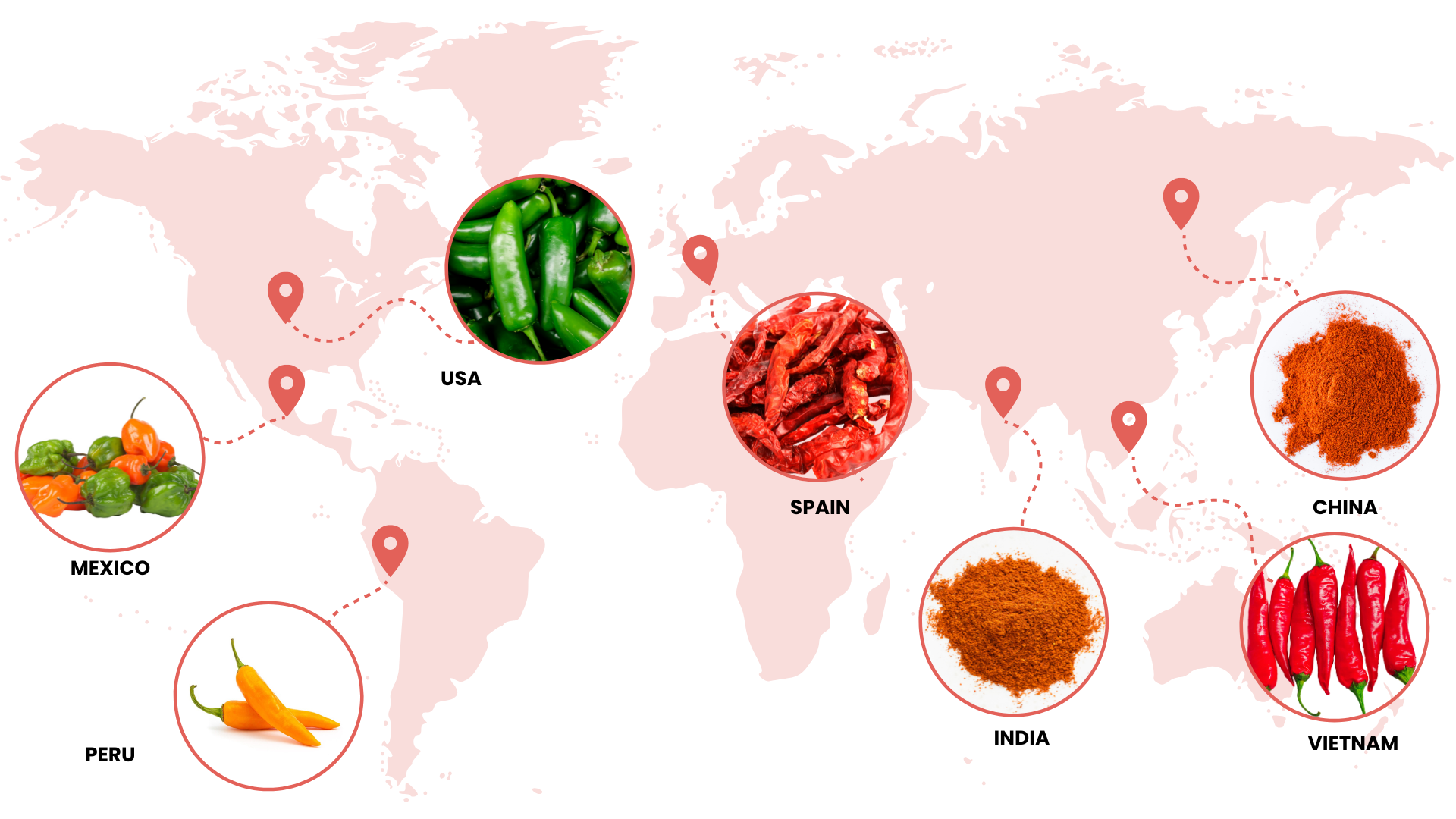Bulk Chilies for Commercial Kitchens and Manufacturers
From fresh and dried whole peppers to ground, crushed, and smoked varieties, our chili offering is tailored for food processors, co-packers, and distributors. Explore by format to find the right match for your application, heat level, or recipe formulation.
Choose the Right Cut for Your Application
Explore Custom Blending Options
From flavor development to bulk consistency, our team works with you to create blends tailored to your product line, application, and scale.
Chilies Around the World
Chili peppers are grown and used across the globe, with each region cultivating unique varieties that shape local cuisines. Use our world map to discover our main chili harvests.

Scoville Heat Scale




Chili peppers vary in pungency, measured by Scoville Heat Units (SHU). Below are heat classifications with common chilies most consumed in the U.S. for each level.
Mild (0–2,500 SHU)
- Bell Pepper: 0 SHU 0%
- Anaheim: 500–2,500 SHU 10%
- Poblano: 1,000–2,000 SHU 12%
Medium (2,500–30,000 SHU)
- Jalapeño: 2,500–8,000 SHU 30%
- Serrano: 10,000–23,000 SHU 35%
- Cayenne: 30,000–50,000 SHU 38%
Hot (30,000–100,000 SHU)
- Tabasco: 30,000–50,000 SHU 60%
- Thai Bird’s Eye: 50,000–100,000 SHU 65%
”Extreme
- Habanero: 100,000–350,000 SHU 75%
- Scotch Bonnet: 100,000–300,000 SHU 78%
- Ghost Pepper: ~1,000,000 SHU 90%
- Carolina Reaper: 1.5–2.2 million SHU 100%
Essential Chili Insights
Choosing the Right Chili for Heat, Flavor, and Cooking
Form matters: Whole chilies are used differently than powders or flakes.
Heat level varies: Mild chilies add flavor, while extreme ones require caution.
Usage dictates choice: Ground chilies are better for spice blends, while fresh or whole-dried ones excel in cooking.
Regional chilies influence cuisine: Mexican, Indian, and Asian chilies dominate global spice traditions.
Chili Pepper Flavor Classifications
Chili peppers are more than just heat—they bring distinct flavors that enhance dishes worldwide. Below are key flavor categories to help you choose the right chili for your needs.
Mild & Sweet (Rich, slightly fruity, minimal heat)
- Bell Pepper – Sweet, crisp, and mild.
- Kashmiri Chili – Deep red color, mild spice, slightly sweet.
- Ancho – Dried poblano, mild with raisin-like sweetness.
- Mulato – Darker, richer, with hints of chocolate and licorice.
Smoky & Earthy (Bold, deep, and fire-kissed flavors)
- Chipotle – Smoked jalapeño, medium heat, rich smoke.
- Pimentón (Smoked Paprika) (Mild to Hot) – Spanish chili, smoky and slightly sweet.
- Pasilla – Earthy, deep, with dried fruit notes.
Fruity & Citrusy (Bright, tropical, tangy flavors)
- Habanero – Sweet, floral, intense heat.
- Scotch Bonnet – Tropical, mango-like sweetness.
- Ají Amarillo – Peruvian chili, fruity with passion fruit notes.
Spicy & Pungent (Sharp, aggressive, forward heat)
- Thai Bird’s Eye – Quick, piercing heat, slightly grassy.
- Serrano – Fresh, bright, and sharper than jalapeño.
- Cayenne – Sharp heat, commonly used in dried spice.
Fermented & Umami-Rich (Aged, deep, complex flavors)
- Gochugaru – Korean chili, mild with smoky-sweet undertones.
- Gochujang (Medium Heat) – Fermented Korean chili paste with deep umami.
- Chili Bean Paste (Doubanjiang) (Varies) – Fermented Chinese chili paste, rich and salty.
Industry Reports for Bulk Spice Buyers
Subscribe to receive monthly market updates tailored to food manufacturers, distributors, and large-scale spice buyers.
Get early insights on pricing shifts, supply chain updates, and global sourcing trends designed to support smart purchasing and long-term planning.
Contact
Sales
Purchasing
Logistics
Address
Los Angeles, CA






